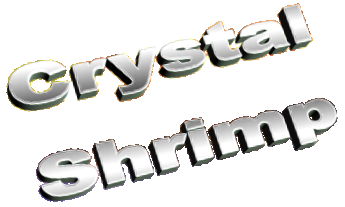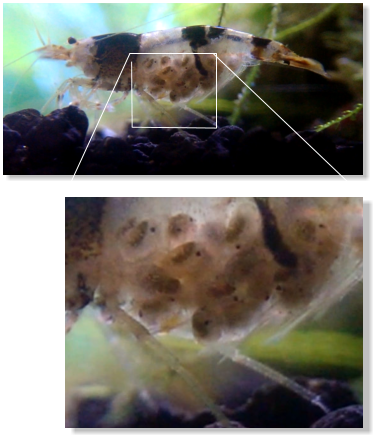








Crystal Red/blackShrimp
CARING & BREEDING FOR CRYSTAL RED / BLACK SHRIMP CRS/CBS
Crystal Red Shrimp also known as CRS are a rare and unusual shrimp easily identified by their unique red and white striped markings. The CRS reportedly came to be from a single mutation involving the black bumble bee shrimp in Japan. Years of inbreeding have resulted in a very fragile but beautiful strain of shrimp that has been cultured through generations. Crystal Red shrimp require near perfect water quality to thrive and reproduce. Temperature ~74°F The optimum aquarium temperature for Crystal Red Shrimp is around 70-78°F (22-25°C). Other species might have slightly different temperature / enviroment so it is best to avoid adding others . pH ~6.8 | Hardness 7.0 The pH for Crystal Red/blackshrimp should be slightly acidic from 6.2 – 7.2. This range will maximize health, color and egg hatching rates. Plant substrates such as ADA Amazonia and UpAqua are filled with natural buffers will stabilize the pH to around 6.8. These products are specifically produced to not cloud the water and work with densely planted aquarium. These products are very popular with CRS/CBS. The general hardness should be around ~6-8. TDS should be at about 200-300ppm. There are many commercial products that will help to buffer the aquarium water to these levels. When using a buffer remember to use it with incoming water during water changes. CRS/CBS prefer slightly harder water, this is a definite requirement for breeding CRS/CBS. Nitrite 0ppm CRS/CBS are highly susceptible to even very low levels of nitrite in the aquarium. Nitrite should always be at 0 post cycling. Ammonia 0ppm CRS are very sensitive to any ammonia levels. As with nitrite, ammonia should always be 0 post cycling. Nitrate >20ppm Nitrates should be as close to 0ppm as possible. Any reading under 20ppm is suitable for keeping CRS, elevated levels can be reduced by adding aquatic plants and removing decaying matter. Water Changes On the web will you will find alot of different arguments on how much percent a week/month is best. And ofcourse with CRS the aquarium water quality should be as optimal as possible. However the differences in percentage severely depend on filtration / circulation , the amount of light and also on what you add as avarage in food and ofcourse how many are inside your tank.not to mention if you have them together with fish or not. so to get the ideal rate and percentage of your water changes you will have to either look around the web for people who might have a similar setup as you or find out as you go along. i myself average at about 15% every 2 weeks. NOTE: people tend to rush the water changes and end up killing alot of shrimp in the process. ADDING THE “NEW”WATER SLOWLY IS KEY!! i myself add the water by letting it DRIP inside the tank.NOT POOR IT IN. just grab a bucket/container with water add a small hose to it and squeeze it off so it will only drip. Feeding Crystal Red/black Shrimp CRS are omnivorous requiring a balanced diet. Feeding is important to give the CRS the required nutrients for breeding and birthing healthy young. A balanced diet of fresh vegetables and processed foods are recommended. Boiled zucchini, spinach, flakes, pellets and specialized shrimp foods are important in providing the RCRS with a balanced diet and helping them to develop solid red and white markings. Remove excess food from the aquarium after feeding. This will help with keeping ammonia and nitrites at 0. Crystal Red shrimp will constantly moult and leave their old shells. Do not remove the shells from the aquarium as these will provide much needed calcium in their diet when the shrimp colony consume it. Mosura foods and additives are top of the line supplements and diet additives that can increase the health and virility of CRS/CBS. Serious hobbyists should consider quality products an investment when looking to long term breeding and culture of CRS/CBS. Dangers of CRS/CBS in the Planted Aquarium Shrimp and planted tanks are a perfect compliment for each other in some ways and a disastrous combination in others. When it comes to disasters and keeping shrimp, CO2 injection is probably the biggest killer. This is especially true for DIY CO2 setups. When CO2 is added to aquarium water it dissolves and is absorbed by the plants for photosynthesis. When there is no light source (at night for instance) CO2 is not utilized by the plants and instead forms carbonic acid in the water. This can plummet and swing the pH sometimes dramatically from day to night. Red Cherry shrimp, although tolerant can often not handle the swing in PH nor the lack of oxygen. Using CO2 injection and caring for CRS needs to be done carefully. This may not be as simple as using a solenoid valve to only inject CO2 during light hours. Horror stories have arisen where hobbyists have forgetting to reset there light timers. In the morning when the lights do not turn on but the CO2 starts bubbling there is danger for a giant PH swing and a high risk of stressing your CRS. Fertilizer additives need to be carefully checked before adding them to a Crystal Red shrimp aquarium. Certainly all copper and heavy metal additives should be avoided. Moss and plants will provide CRS with an underwater playground to breed and flourish. Planted tanks are also great for CRS offspring. Even with small fish in the tank CRS are known to breed fast enough to increase population in a densely planted aquarium. Tank mates & Compatibility Unlike Red Cherry shrimp, CRS should be kept exclusively in a species only aquarium. They reproduce much slower than other shrimp strains and the shrimp themselves are valuable and expensive. It is pointless risking both the adults and offspring at the sole purpose of housing fish in the aquarium. They enjoy the company of their own species and should be placed in an aquarium plenty of places to hide and open water to swim. CRS have almost no bio-load. Up to 1000 in a standard sized 55 gallon aquarium would have little strain on the biological filter bacteria. Around 2-5 shrimp per gallon is recommended Grading Crystal Red Shrimp crs how to grade white Crystal Red Shrimp come in many different grades and forms. Their price increases at an exponential rate as the quality of shrimp increases. The grades in order from least to most desirable are C, B, A, S, S+, SS, SSS. There are also a few different ‘types’ within the separate grades. Grades of Crystal Red shrimp are only dependent on thickness and solidity of color banding. The health, size, activeness and life span of the shrimp is identical between all grades. When purchasing CRS spend time looking for shrimp with solid red and white colorations. Brighter whites and deeper reds are desirable and eye-catching in the aquarium. Ensure the shrimp are active, healthy and feeding. It is commonly asked “If you are to breed an SSS graded CRS with another SSS graded CRS will the offspring all be SSS grade?" The answer depends on many environmental factors and unfortunately can never be a certainty. Historically breeding two of the higher grades of CRS yields higher chances of higher graded offspring. Grading is the result of selective breeding. It is therefore possible to increase grades when breeding lower graded shrimp. For example two 'A' grade CRS could breed together to produce a number of 'SS' grade shrimp.













































